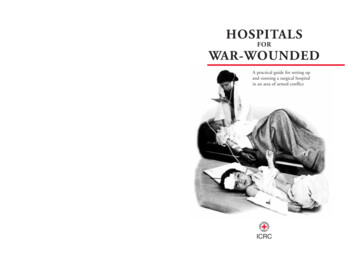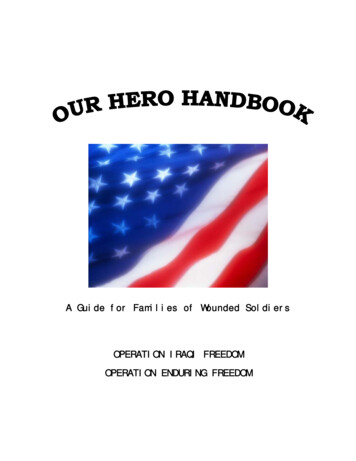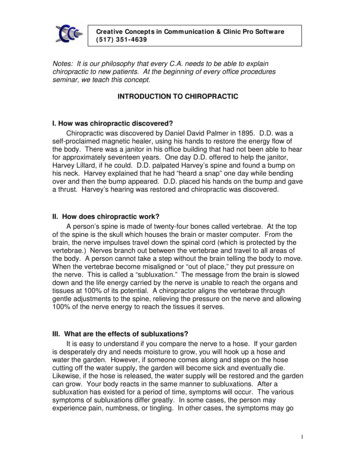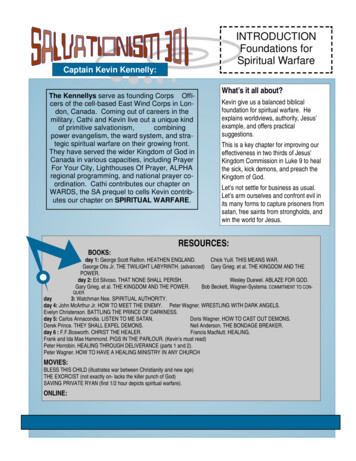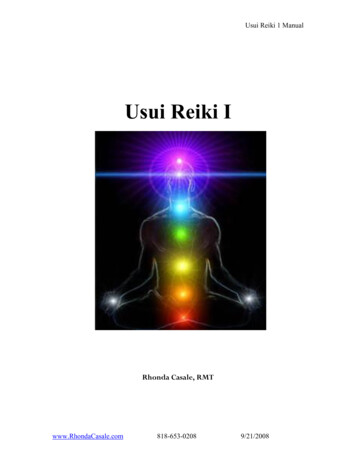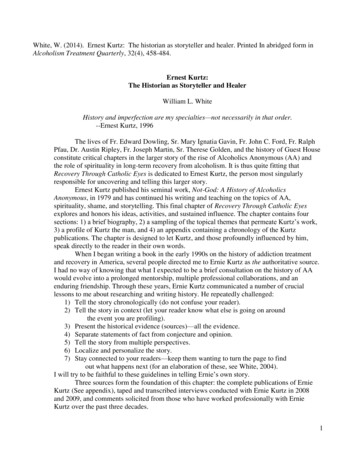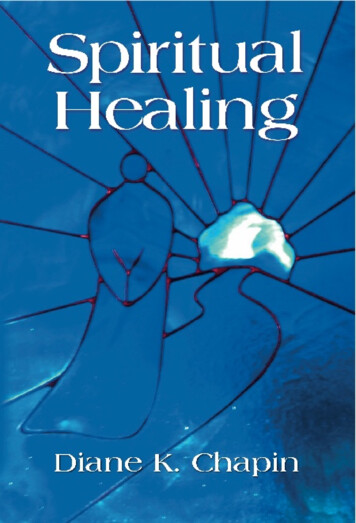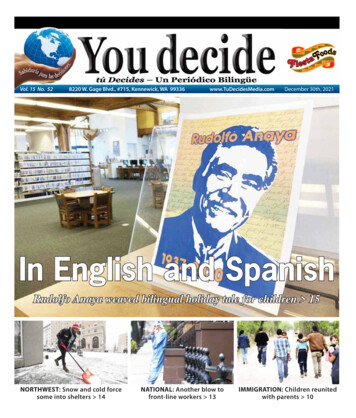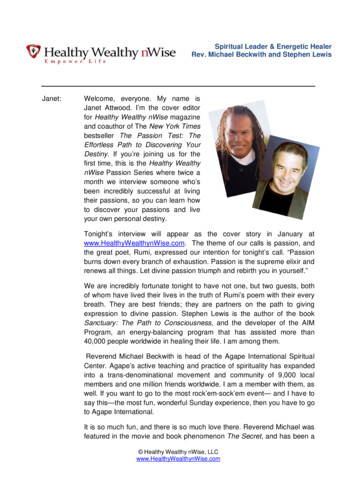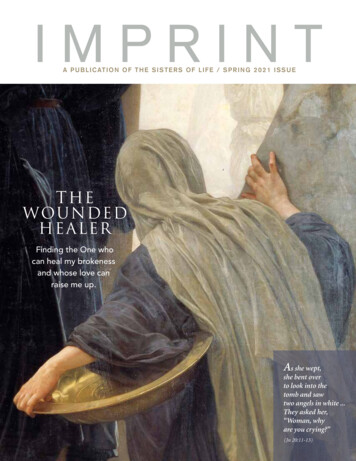
Transcription
IMPRINTA P U B L I C AT I O N O F T H E S I S T E R S O F L I F E / S P R I N G 2 0 2 1 I S S U ET HEW O UN DEDH E AL ERFinding the One whocan heal my brokenessand whose love canraise me up.As she wept,she bent overto look into thetomb and sawtwo angels in white .They asked her,“Woman, whyare you crying?”(Jn 20:11-13)
NWhat do you want Meto do for you?(Mt 20:32)othing in our life, no suffering orpain, goes unseen by God. Your brokennessdoes not disqualify you from His love. In fact,it is quite the opposite: each place of brokenness that we allow Jesus to touch and to healbecomes a wellspring of grace overflowingwith love and peace.Jesus knows intimately what it means tosuffer because He entered into our sufferingand redeemed us through it. Jesus Christ is afromwounded healer. When God became man, itwas to deliver us from the suffering of this world.“By His wounds you have been healed” (1 Pet 2:24).In the Gospels, as Jesus encounters thosewho suffer, He asks, “What do you wantme to do for you?” (Mt 20:32; Mk 10:51;Lk 18:41). In this question lies an invitation to look into the depths of our hearts,beyond what the world tells us we need,to the truth that Love is the answer toevery human longing.deat h to lifeJesus sees the places where we are blind (Mk 8: 22-26),where we are lame (Jn 5:1-15), where we are bleeding(Mt 9:20-22), and His heart is moved in love. These are theplaces He desires to encounter us, to console us, and toplace us in the loving embrace of God the Father. When weallow Jesus to touch our wounds, we experience a peace theworld cannot give. It is precisely from these places that Hisvictory shines most brightly, defying all human logic. It is inseeing the impossible become possible, bringing life fromdeath, that He increases our faith.What do you want Jesusto do for you?As we celebrate His rising this Easter season, may youencounter anew His healing touch and His thirst tobring about the glory of the Resurrection in your life.May Our Lady be your guide and lead you in hope.Know of our prayers for you and your loved ones atthis time. Blessed Easter!In Christ, Our Life,Mother Agnes Mary, SV
Healing of a Blind Man by Brian Jekel / Printed with permission.BEHOLDI make all things new. (Rev 21:5)“Man is a relational being. And ifhis first, fundamental relationshipis disturbed — his relationship withGod — then nothing else can betruly in order. This is where thepriority lies in Jesus’ message andministry: before all else, He wantsto point man toward the essenceof his malady, and to show him —if you are not healed there, thenhowever many good things youmay find, you are not truly healed.”-Pope Benedict XVIby Sr. Lucia Christi, SVWe all need healing from something.We may find ourselves in need of healing from illness or injury;from addiction; from emotional wounds, such as rejection,abandonment, or shame. We may be hurting from broken relationships and accompanying fear, or an inability to trust others;from distorted views of ourselves or others; from the effects ofour own sin or the sins of others. Since the fall of Adam and Eve,suffering is part of the reality we face. But we know it is not theend. We rebel against pain; we desire healing because we knowin our hearts that we were not made for suffering.And here is the good news: Jesus has revealed Himself to be ourHealer. He, the Divine Physician, knows the intricacies of ourhearts and where we are in need of restoration! The remedyHe provides is so delicately and tenderly attuned to each of ourhistories, wounds, circumstances, and our faith.Remember Jesus healing in the Gospels: some people He healsimmediately, without their even asking (like Peter’s mother-inlaw); some, He heals in stages (like the blind man who at firstsaw “people like trees walking” [Mk 8:24] before he gainedhis full sight). For others, He heals with a simple word from adistance (like the royal official’s son). Sometimes Jesus spends allday and night healing everyone who comes to Him; at othertimes, He says He must move on, because He has to preachthe Gospel in other towns.Ultimately, Jesus comes to heal every one of us, but perhapsnot in the way that we expect. This life is passing away, andall suffering will eventually cease. So His greatest concernis for our salvation. He desires to heal us from our deepestwound: our sin. So even if we don’t experience physicalhealing now, we know with certainty that Jesus is workingto bring about healing in our souls, by constantly calling usto return to Him with repentance and offering us His forgiveness. This is the healing that leads to eternal life.No matter where or how we may be wounded, the unshakeable truth is that our life is good. Each one of us was createdby Love, in Love, for Love, and this can never be damaged,lost, or taken away. We find healing in this truth, in the totalsecurity of God’s love for us. And as we believe it more andmore in this life, we come closer to what we will perfectlyknow and receive in heaven: where “[God] will wipe everytear from their eyes, and there shall be no more death ormourning, wailing or pain . The one who sat on the thronesaid, ‘Behold, I make all things new’” (Rev 21:4-5).
An interview with Michelle Schachleby Sr. Mary Margaret Hope, SVand Sr. Zelie Maria Louis, SVMichelle Schachle and her husband Daniel never expected tobe at the center of the miracleleading to the Beatification ofKnights of Columbus FounderBlessed Fr. Michael J. McGivney(1852-1890). But God’s healing power streamed into theirDickson, Tennessee family inan extraordinary way whenMichelle was pregnant withMichael, their 13th child.Can you share a little of your own story?My story starts before I was born. When my mother was pregnant with me, she and my father were about to get a divorce.She was pushed very hard to have an abortion; if she didn’t, sheknew that she would have to raise us by herself. She said “no”to the abortion. After my father left, we moved to Tennessee.My mother remarried, but my stepfather was abusive. He wasreally the only father I ever had. It took a lot of years to heal fromthat. When I was 18, I found myself pregnant, and I married theboy. But the baby was stillborn, and I think that triggered a lotof my childhood pain. I lived with it for many years.How did you and your husband Daniel meet?We like to tell everyone that we met in the “Pen.” We bothworked in this big old prison, in the little town where I grew up.At the time, I was a single mom with twin girls who were aboutthree years old. Dan and I knew each other for two years, andhe kept asking me to marry him, and I kept saying “no.” Thenone day, he had one of my children on his shoulders, and I said,“I appreciate how much you love her because she’s my child.”He said, “I don’t. I love her because she’s my child.” After thatremark, I married him.But there was a lot of pain in the beginning of our marriagebecause we weren’t living right. I became Catholic after Imarried Daniel, and we learned a lot going through RCIAtogether. We slowly decided to follow God, making littledaily choices.You made some big choices, too.We decided we would be open to life. I mean, you don’tplan on having 13 kids. When Dan said he wanted a largefamily, I was thinking four or five. But it was all the dailychoices we made, even when they were hard, that gave usthe grace for God to use us in this way. But He had to allowa lot of pain to bring us to that moment.Tell us about Michael’s diagnosis.When I was pregnant with Michael, we went to get anultrasound. The doctors called me to tell me the baby wasa boy and that he had Down Syndrome. I called Daniel. Hesaid, “That’s the most wonderful news I’ve ever heard in mylife.” I said, “But I’m going to need someone to help me.”
I knew a child with Down Syndrome was going to need a lot ofextra care, and I just needed Dan to know that I needed help.He said, “Okay.” So I said, “Okay, we can do this.”But when I was almost 20 weeks pregnant, they did an extensive ultrasound. They called us into a room, a really small roomthat had lots of screens. The doctor was pulling up all thesedifferent images. She began to explain to us what fetal hydropsis. She showed us on the ultrasound how there was fluid allthrough his body, in his lungs, through his skin. Some childrenthey can treat, but when fetal hydrops is connected with agenetic condition, there’s nothing they can do about it.Did the doctor give you any hope?The doctor said, “I’m sorry,there’s nothing we can do.He’s going to die.” Dansaid, “I need a percentage.What’s the percentage thathe will live?” She said, “I’msorry, Dan. Zero. I’ve beendoing this a long, longtime, and I’ve never had ababy survive this. It’s alsoimportant for you to knowthat Michelle can get whathe has (Mirror Syndrome),and she can die. You caninduce now, or you can wait and deliver after the baby dies but if Michelle starts getting Mirror Syndrome, we may need tohave a very serious conversation.”What did you do?Dan was so angry at her for telling us to induce, but I neverwas. I knew that I could die. But I said, “We’re going to pray.”Dan works for the Knights of Columbus, and it was just afew days before we were supposed to go on an employeepilgrimage to Fatima. Later that night, I was a little hysterical,and I laid down on the floor to cry. That’s when Dan prayedto Fr. McGivney, “I don’t know what to do. But I know youneed a miracle. And if you pray for my son, we’ll name himafter you.”So, you started calling the baby “Michael”?Actually, we had a bit of a disagreement. I really wanted toname him after my grandfather Ben, who was called “Lucky.”But Dan stood up and said, “He’s going to be fine. We’re goingto Fatima, Fr. McGivney’s going to pray for him, and we’re going to name him Michael. We’re naming him Michael becausethere’s going to be a miracle.” For a few minutes I was upset,then I thought, “Well, Fr. McGivney does need a miracle.” Thenext morning, we were emailing our friends: “We’re going tobe in Fatima on this day, and we’re requesting through the intercession of Fr. Michael J. McGivney that the baby be healed.”But my friend who helped send the emails out still had a burialgown made for him, just being honest.What happened on your pilgrimage?The day we landed in Rome, the Holy Father announced theYear of Mercy. I remember thinking, “Mercy, Lord. Mercy.”That day for Mass, our pastor just randomly picked the altarthat the Knights of Columbus had refurbished, which had abeautiful icon of Our Lady holding the Baby Jesus. And whenwe got to Fatima, the Gospel during Mass was the one whereJesus says to the official in Cana who asks Him to heal his son,“Unless you people see signs and wonders, you will not believe You may go; your son will live” (Jn 4:48;50). Hearingthat verse gave us great hope.What happened when you returned home?The doctor had told me, “You’re going to be fine . but it’llprobably get pretty seriousquick when you return.”I went back to the doctorwithin a day or two after weflew back. I was terrified. Thetechnician was taking a longtime. I saw something whiteon the baby’s lungs, and Istarted crying. I said, “Is thatfluid?” She looked at me andsaid, “Michelle, this is theprettiest baby I’ve ever seenin my life.”I said, confused, “I was told there was no hope.” The doctorsaid, “Michelle, didn’t you just come back from Fatima? WithGod there’s always hope. There’s a little wet spot on his lung,but it’s really not a big deal. What’s your baby’s name?” I said,“Well, there’s been a lot of controversy over that in our family, but his name is Michael.”How did you know it was a miracle?The first doctor called every specialist in hydrops she knew.She was so afraid that she might have made a mistake in telling me to induce. But they all told her, “No, there’s no wayyou made a mistake.” I actually had hydrops when he wasborn. I had Mirror Syndrome. That’s part of the miracle. Howcould Michael not have it, but I did? The doctor came aroundafter he was born and said, “It’s been the honor of my life todeliver your baby, your little miracle, your precious baby.”And he was born on the anniversary of the charter of the veryfirst chapter of the Knights. And Fr. McGivney and I share abirthday. God was saying over and over again that He meantfor this to happen. Fr. McGivney chose us. We were chosenbefore time; in God’s mind, this would happen.Has this physical healing brought other healing intoyour life?I’ve always been able to say I love Jesus, but I was never ableto say that I loved God the Father. I didn’t have a father toteach me how to love. It really wasn’t until after the miraclewhen I told someone, “God the Father can never be outdone
in generosity,” that I realized how afraid I had been to love the Father. But nowI could see that He knew my story, and He was there with me through it all.He loved me, a Mary Magdalene. I’m not the Virgin Mary. I’m not pure, but Hecame into my body, into my womb, and performed a miracle inside of me. Heloved me fully. That’s what God does — He performs miracles inside of us.Why do you think Michael wasn’t healed of Down Syndrome?It never crossed our minds to pray for that. It would be like saying, “God, Idon’t want my Bella to have her beautiful voice; I don’t want Leo to have hisgreen eyes.” That’s part of who they are. Who am I to tell God, “I don’t wantthat gift; give me another one”? He is the Maker of life! My favorite part of it allis that Michael’s story is important becausehe has Down Syndrome, not in spite of it.This was a little wink from God that He approves of how the Knights have carried onFr. McGivney’s mission by what they havedone for the unborn, for the disabled, forthe widows and orphans.How has Michael changed you andyour family?Having a child with special needs is sucha gift. It shifts you from turning inwardto turning outward. It’s crazy. I went from thinking, “O Lord, You are goingto have to help me; I’m already overwhelmed and now I am going to have ababy with special needs!” to thinking, “God, I just want this baby with specialneeds. Can I have him for a day? Can he live for a month? Can he just live?”And there’s just a love that Michael has that is unadulterated and beautiful.He just loves and teaches you to love. How can you look at Michael and notknow that God is real? Yes, he poured a whole gallon of milk on the floor .but how can you not say “thank you” for a little relic that runs around andsays, “Mommy, I love you”? I will spend eternity thanking God for what Hehas done in our lives. It’s changed everything.What would you say to families who are struggling?People think we’re “so holy,” but we’re not a perfect family. We have all thethings that happen in a real family in this age. That’s the beauty of the story:God loves us where we are. He loves all of us and has a plan. It was part of theGospel reading that day at Fatima, after the official’s son was healed, that “hiswhole household believed” (Jn 4:53). We still have children that are away fromthe faith, but I have been clinging to that promise. He’s theGod of mercy. If we follow God’s plan, He’s going to dogreat things He’s going to write our story. We just havegive Him a little tiny bit.KNIGHTS OF COLUMBUS:Founded to protect and care for the needs of widows, orphans,immigrants, and refugees, the Knights of Columbus are a worldwide spiritual organization of Catholic men who seek to buildup the Church and help families grow closer to Christ. Deeplycommitted to the cause of human life, they have been an unfailingsupport to our lives and our missions, and we thank them fromthe bottom of our hearts for their incredible generosity andwitness. For more information: kofc.orgFun fact: Beatification is one step on the way to declaring someone a saint.In addition to the evidence of a holy life, one verified miracle occurring afterthe person’s death is necessary for the Church to declare them “blessed”.THETRUEVISIONT H AT H E A L SYOU ARE CHOSENYOU ARE A GIFTby Sr. Zelie Maria Louis, SVFreedom comes from living in the truth ofwho we are and who God is (cf. Jn 8:32).Seeking God’s vision of each person, createdin His image and likeness, powerfully freesour hearts to love as He loves. By immersing ourselves in the truth of God’s love, wecome to see that each person He creates isintentional. No one is a mistake or accident.Women we’ve served:Sarah* received an adverse prenatal diagnosis for her baby boy. She listened to the doctor’slong list of things her son would likely not beable to do. When he finished, she paused andasked the one question most on her mother’sheart: “But . will he be able to play?”Kelly*, when asked to have test after testdone to determine the potential limitations ofher baby in the womb, said, “I don’t need anytests. I will love her the same no matterwhat she can or can’t do.” She lived the truththat the goodness of her daughter’s life was measured by love, not by capabilities.The simple and profound truth is this: Godwills each life not based on what a personcan do, but simply because of His love. Thisis the true vision that heals our eyes andlets them see each human life as God sees.To approach each person with a reverentaffirmation of his or her inherent dignity,simply because God delighted to create thisperson, is to allow the truth to heal us.* Names changed for anonymity.
HEALING THROUGHFORGIVENESSAn interview with Fr. John Burnsby Sr. Maris Stella, SV and Sr. Fidelity Grace, SVFr. John Burns is a priest of the Archdiocese of Milwaukee. Hestudied Business Marketing and worked in commercial fishing offthe coast of Australia before realizing the deeper call to become a“fisher of men.” He was ordained to the priesthood in 2010, andcompleted a doctorate on the theology of healing through forgiveness. He speaks at conferences, preaches missions, and directs retreatsthroughout the country. He is the author of Lift Up Your Heart: A10-Day Personal Retreat with St. Francis de Sales, and is a retreatdirector for the Sisters of Life and the Missionaries of Charity.How have you witnessed people find healing throughforgiveness?I have been amazed and brought to tears in witnessing thepower of God’s grace to bring order and to heal what hasbeen wounded by sin. I have walked with people who werestuck in physical, emotional, psychological pain — and evendiabolical oppression — until they forgave. I can say withconfidence that there is simply no deep healing without someengagement of forgiveness.How would you define forgiveness?The idea of forgiveness often intimidates people. It can appearthat forgiveness fails to uphold justice, and in other situations,forgiveness — especially for men — seems like a form ofweakness. In cases of severe trauma or deep pain, the ideaof confronting one’s offender is terrifying and even imprudent. Forgiveness is first and foremost a matter of the heart.Forgiveness can be achieved even without interaction andreconciliation with one’s offender. This means we are ableto forgive those who are deceased or with whom it is impossible or unsafe to communicate. This fact is incrediblyhopeful. In terms of a concrete definition, mature and lasting forgiveness entails several components: the choice tolet go of the quest for revenge, the emotional release of thedemand for repayment, the decision to leave the pursuitof justice to another authority (either God or civil authority), and the pivot from ill-will to good-will, where the onewho forgives shifts the posture of his/her heart toward theoffender from curse to blessing. When we truly forgive, weshare in the gift of Jesus Christ on the Cross as we offer anundeserved gift to one who has hurt us.What are the most common wounds we experience, and how do they affect us?The pain we bear in our hearts can be complicated andlayered. Our wounds were likely inflicted as a fruit of sin,
and sin is the playground of evil. The evil one sows lies aroundour wounds that distort the truth about ourselves, about others, and even about God. Dr. Bob Schuchts names seven majorwounds: rejection, abandonment, fear, shame, powerlessness,hopelessness, and confusion. These wounds assert an agonizing but often subtle influence over our hearts, as we experiencetremendous uncertainty about ourselves and our ability toflourish. We might feel like our hearts are just never going to bewhole. We tend to replay the wounding incident over and overagain, which leads to resentment — literally a “re-feeling” of thesorrow and anger aroused by the injustice. We might feel broken, dirty, misunderstood, forgotten, ashamed, and enraged allat once. But we want to renounce the lies that have trapped usand replace them with the truth of our identity in Christ Jesus.What’s the first step in the forgiveness process?First, we have to take an account of ourpain — how we’ve been hurt and who hashurt us. It’s important to honestly recognize and feel our sorrow and resentment(to weep or cry out in anger) rather thandeny or suppress our emotions. Theseemotions are telling us something aboutwhat went wrong and, in turn, about ourhearts; to avoid them or suppress themamounts to a form of dishonesty. Yet, ashelpful and important as our emotionsare, we also recognize that they so easilymislead us, and so they must be addressedrationally. We have to look at the peopletoward whom we feel sorrow, anger, andresentment, and make a decision: do wecontinue on the road toward which ouremotions point, which is toward revenge,or are we willing to choose another way? When we feel stuck, itis helpful to recognize the binding force of unforgiveness. Christreminds us, “Unless you forgive others your trespasses, yourFather will not forgive you yours” (Mt 6:15). Unforgiveness, theplace out of which we plot revenge and stew in hatred, actuallycloses our hearts to God’s mercy. And we have to admit thatour attempts to live with the anger or to get rid of the resentment on our own terms simply have not worked, but have onlyintensified our anger.come to share God’s desire for the well-being and salvationof all persons, even our enemies.And the final step?Finally, we can pronounce, in Jesus’ name, words of forgiveness. Over time, with Christ as our model, we can pray foror practice charity towards those who persecute us. This is adivine achievement. It is a pure gift.What if it doesn’t feel like we have forgiven another?People often ask this question, and it eludes a catch-allanswer because each heart is unique. What can be said universally is that stepping into forgiveness and sharing Christ’sheart in forgiveness is like the emotional solution we neverknew we needed. As we forgive, we discover the overlyintense emotions lose their chokehold on the heart. Evenif they do not fully disperse, the posture of our heart hasshifted and thus evil no longer has such atextured and craggy landscape within whichto hide. In forgiveness, we step out of thedarkness and into the light, making a moralchoice that has real implications — whetherthey are immediately felt or not. Becausewe have chosen the way of Jesus Christ, wecan make an act of faith that something realhas occurred within us. This allows grace towork within us. Eventually, with repetitionof the forgiveness process, the emotions dofollow.I can say withconfidence thatthere is simplyno deep healingwithout someengagement offorgiveness.What do we do after we’ve let ourselves be real withour emotions?We release our debtors and surrender the administration of justice to God and, if fitting, to another authority. With God’s help,we begin to discover the other person as he or she is beforeGod: broken, in need of healing, and often carrying a long storyof pain that we usually cannot see. We can — difficult as it maybe — even come to unite our pain to His upon the Cross andoffer it for the salvation of the very ones who hurt us. Eventuallyin prayer, we may place ourselves at the foot of the Cross, withour offenders. We observe the face of Christ who looks uponthem with love as He suffers for their salvation. Gradually, weOne of the most common reasons we oftendon’t feel like we have forgiven is becausewe unknowingly skip over the structure ofour emotions. If we want to forgive someone who has hurt us, we have to forgive them for each of thewounds they have inflicted on us. We have to be consciousof the specific acts done (great and small) and the emotionsthat follow. This is a process that takes time. It can seemdaunting, but if we skip this, the emotions keep us trappedin the insistence for repayment and punishment. The goodnews here is that each act of forgiveness for each specific injury weakens the power of our inordinate emotions. Choosing forgiveness often requires a repeated renewal of thatchoice.How can we find healing for painful memories?Because God sees past, present, and future in a singleglance, He knows how our whole story fits together. Thehealing of memories amounts to a Divine retelling of ourstory, through which our recollection (memory) of eventscomes to align more with God’s perspective of our past.Even though we might wish parts of our story away, Goddoes not. God sees perfectly well how the places of painand suffering are filled with potential for mercy and healinglove. He purifies our memories in the light of grace to revealHis power, love, and care. Our pain forces us to recognize
our inability to survive on our own. When it is offered to God, wediscover, like St. Paul, that in our weakness we are made strong (cf.2 Cor 12:10).The process of praying with memories begins by calling on theHoly Spirit, begging the Lord to show us how He sees the eventsthat still cause us such pain. In prayer, when we observe the eventsof our painful past with God, we learn that God was also there.We discover that the moment of wounding was not a moment ofabandonment at all. Rather, it was a moment in which the Lordallowed something that, although painful, would eventually leadus to the deeper knowledge of God’s goodness that comes to us inthe present as healing. In the end, our pain is either a weapon forSatan or a powerful instrument for the Lord. In the Divine embrace,our pain becomes the pathway to the most profound and beautifuldimensions of God’s love.How do we persevere when we struggle with painfulemotions?Because psychology offers us so much help in the realm of healing,we may risk falling into some form of self-reliance, thinking we canheal ourselves without God. But when our emotions churn wildlyand we feel like we’ve lost control, the most important thing wecan do is surrender control and turn our attention to God; we canwelcome His presence and the power of His healing gaze. Sacramental grace and contemplation of the truth will always bear morefruit in us than any of our own independent efforts. Also, the mostoverlooked dimension of healing is the practice of virtue, whichbrings order to our passions.How does healing happen, ultimately?The deepest dimensions of healing are really quite miraculous. Wecannot adequately describe how we are made well; we just knowit happened. Healing takes place in a secret way, only fully understood to God, and felt intimately by each broken heart. Healing issimply about the restorative power of authentic love that replacesour pain. We are reminded of who we really are — beloved sonsand daughters of the Father, who holds us tenderly in His love.BOOKS ON HEALINGTop 10 PicksHEALING(Top left to right)Be Healed, Dr. Bob SchuchtsUnbound, Neal Lozanol Feeling & Healing YourEmotions, Conrad Baars, M.D.l Real Suffering, Dr. Bob Schuchtsl Setting Captives Free,Timothy Gallagher, OMVl 8 Keys to Forgiveness,Robert Enrightl Healing, Mary Healyl Hurting in the Church,Fr. Thomas Bergl Healing the Original Wound,Benedict Groeschel, CFRl Abba’s Heart, Neal LozanollSAINTS OF FORGIVENESSForgiveness is hard. But we can ask the Saints tohelp us because they experienced the same struggles.St. Stephen, the first martyr, echoed Christ’sforgiveness for His persecutors, asking that this sinnot be held against those who were stoning him.St. Maria Goretti appeared in a dream to herattacker, Alessandro, with 14 lilies – one for eachstab wound he gave her. Aware of her forgiveness,he radically changed his life and was present ather canonization.St. Isaac Jogues encouraged his fellowprisoners – later known as the “North AmericanMartyrs” – to offer their sufferings for theconversion of their captors.St. Ignatius of Loyola walked 100 miles inthe winter to nurse a man fallen ill – a man whohad, weeks earlier, stolen his paltry savings.St. Edmund Campion publicly forgave thecouncil that condemned him for celebrating aCatholic Mass (when Roman Catholicism wasoutlawed in England) and prayed for the queenjust before his execution.St. Teresa of Calcutta placed flowers andprayed at the grave of the Albanian dictator whohad refused her entrance into her homeland andvisas for her family.FORGIVENESS IN A NUT SHELLWHAT FORGIVENESS IS:1. It is letting go of a debt(something owed to me in justice)2. It is accepting and living in God’s grace ofgenerosity and mercy3. It is letting Jesus transform hurt into a blessingWHAT FORGIVENESS IS NOT:1. It doesn’t mean forgetting completely2 It’s not excusing the offender(as if he/she did no wrong)3. It’s not only about feelings4. It’s not denying justice/punishment by authority5. It doesn’t necessarily require interaction(e.g. the person has died)6. It’s not necessarily entering back into relationship(not always safe or possible)
by Sr. Maeve Nativitas, SVLet’s just say I’m in the workplace and feel likesomebody is questioning my judgement, andI experience this immediate defensive anger. Ican try to grit my teeth and not be angry, but it’svery hard to do that – and, eventually, I won’tbe able to keep it up. There’s actually something deeper that God wants to heal here. Thisprovides an instance for me to be able to reflect:“Why do I feel angry? I feel angry because I feelpain. Why do I feel
suffer because He entered into our suffering and redeemed us through it. Jesus Christ is a wounded healer. When God became man, it was to deliver us from the suffering of this world. “By His wounds you have been healed” (1 Pet 2:24). Jesus sees the places where we are blind (Mk 8: 22-
